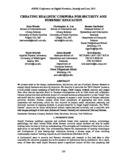Digital Forensics Research: The Next 10 Years
| dc.contributor.author | Garfinkel, Simson | |
| dc.date.accessioned | 2015-01-07T22:12:54Z | |
| dc.date.available | 2015-01-07T22:12:54Z | |
| dc.date.issued | 2010 | |
| dc.identifier.citation | Garfinkel, Simson, Digital Forensics Research: The Next 10 Years, DFRWS 2010, Portland, OR, August 2010 (Acceptance rate: 40%, 16/39) | |
| dc.identifier.uri | https://hdl.handle.net/10945/44251 | |
| dc.description | DFRWS 2010, Portland, OR, August 2010 | en_US |
| dc.description | The article of record as published may be found at http://dx.doi.org/10.1016/j.diin.2010.05.009 | en_US |
| dc.description | Refereed Conference Paper | en_US |
| dc.description.abstract | Today's Golden Age of computer forensics is quickly coming to an end. Without a clear strategy for enabling research efforts that build upon one another, forensic research will fall behind the market, tools will become increasingly obsolete, and law enforcement, military and other users of computer forensics products will be unable to rely on the results of forensic analysis. This article summarizes current forensic research directions and argues that to move forward the community needs to adopt standardized, modular approaches for data representation and forensic processing. | en_US |
| dc.rights | This publication is a work of the U.S. Government as defined in Title 17, United States Code, Section 101. Copyright protection is not available for this work in the United States. | en_US |
| dc.title | Digital Forensics Research: The Next 10 Years | en_US |
| dc.type | Paper | en_US |
| dc.subject.author | Forensics | en_US |
| dc.subject.author | Human subjects research | en_US |
| dc.subject.author | Corpora | en_US |
| dc.subject.author | Real data corpus | en_US |
| dc.subject.author | Realistic data | en_US |





